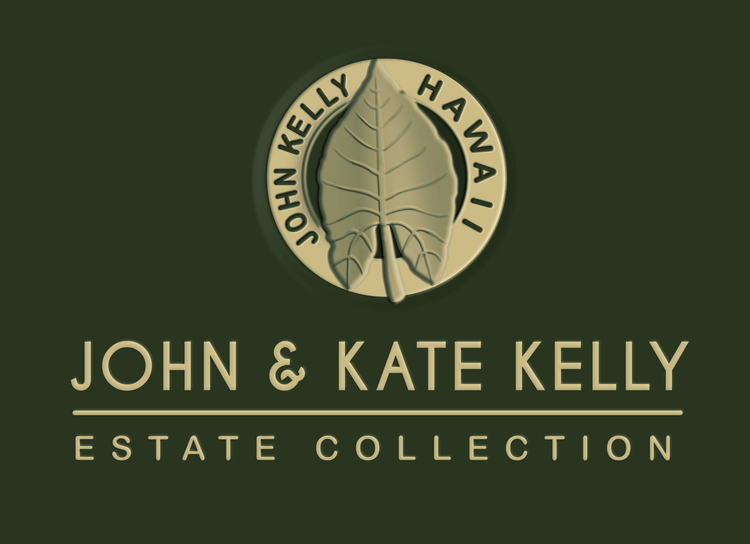JOHN KELLY’S ART AND TECHNIQUE THROUGH THE YEARS
Self Portrait
John’s images capture the profound beauty of the Islands as well as the hardship for a people adjusting to difficult changes. Hawaiians were being pushed off their lands that were targeted for resort hotels, military bases and yacht harbors. Hawai’i was in transition as tourism steadily emerged as the economic engine for the Islands.
John’s art reflects Native Hawaiian men and women working as lei sellers, fishermen, dancers, and farmers. His work is a testament to the beauty of Polynesian people and to the lives of an indigenous people who have maintained their culture in spite of having been vacated from their homes, farms, fishing grounds and beaches.
“Color etching in the true sense of the word is one of the most painstaking of all media and John Kelly has mastered this technique like no other artist in America.”
THE EARLY PERIOD
(1920 TO MID 1930'S)
Gillnet Fisherman
Haku Lei
Tutu
John Kelly was a gifted graphic artist who worked as an illustrator primarily for newspapers but also freelanced in advertising. He and his artist wife, Kate, a talented sculptor, moved from San Francisco to Hawai’i in 1923 with their young son, John Jr.
John’s interest in etching evolved from his work as a graphic artist for newspapers (San Francisco Examiner and the Honolulu Star Bulletin). He was º––familiar with reversing images and was drawn to the detail that etching demanded. The first publication of his art in Hawai’i was of a spear fisherman and was featured on the cover of a local trade magazine in 1926.
Net Fishermen, Drypoint Etching
John’s earliest subjects were the Native Hawaiian people who lived in the Kelly’s immediate community. Kate and John built a modest house in a remote area on the outskirts of Honolulu situated on a barren lava rock outflow. They soon made friends with individuals who lived in a nearby fishing village. These friends became the primary focus of John’s art.
Photo by Kate Kelly
Amoka
John began etching using the dry point technique: a sharp point scratched into the copper plate. He worked primarily with black ink on a small roller press he had shipped to Honolulu from California.
Around 1930, Kate, who was also an accomplished photographer, began to photograph their neighbors, friends and acquaintances, many became the subjects of John’s etchings. Her photographs captured the kindly spirit, the amazing skills and the steadfastness of the Hawaiian people at a time of tremendous transition. Many Hawaiians were being displaced from the Waikiki area known for fresh water springs where abundant taro fields were tended and net fishing was a way of life. Hotels replaced Hawaiian communities as the lo’i (taro fields) were replaced with hotels. As a result, Hawaiian people survived by selling fish and flower lei.
Lei Makers, Drypoint Etching
Hawaiian People making Lei for those arriving on ships at Aloha Tower.
THE MIDDLE PERIOD
(MID 1930'S TO MID 1940'S)
Gillnet Fishermen
Hawaiian Madonna
Tapa Skirt
In the mid 1930's, John began to experiment with color using a wide range of rich tones. He sought to reproduce the colors that he saw reflected in the people and the wondrous environment. He became renown for contrasting earth tones and radiant colors. In this period, he also perfected a method of printmaking known as aquatint. This is a very complex technique that employs resins (a resistant) and acids on copper plates.
His mastery of perfect registry and advanced techniques—recognized nation-wide as extraordinary—remains unparalleled today.
Nanea, Color Aquatint
Hawaiian Head, Color Aquatint
Kate Kelly's Photo
Some of Kate’s photographs became the subjects of John’s etchings.
The Kelly home became a gathering place for neighbors and friends who lived in the surrounding area. The kind and fun-loving Kelly’s often hosted pa'ina, gatherings with music, hula and food for sharing. As a result, their young son grew up immersed in Hawaiian culture and was taught net fishing, surfing and skin diving.
The home also served as a gallery for John’s work and was frequented by visitors interested in his art.
Dressing for Hula
Red Pareau
THE LATER YEARS
(1945 THROUGH THE 1950'S)
Uhu Fisherman
Spanish Hawaiian
Hula Skirt
Hawaiian Soldier
Hawaiian Girls
Nude Study
John also experimented with oil and water color during the 1950's. Below features ulu or breadfruit harvest and lei makers.
Lei Makers on the Green
Kate’s interest in the emerging Baha’i Faith influenced John’s attraction to representing Asian subjects. Baha’i opposes war and embraces all of the major spiritual teachings. They began collecting books of art depicting Buddha, Bodhisattva, Quan Yin and other deities who ultimately became John subjects. His Asian period featured numerous incredibly detailed Boddhisattva and extended into the late 1950's.





























